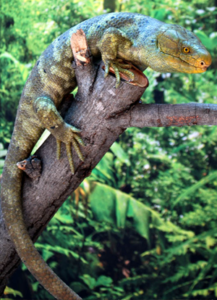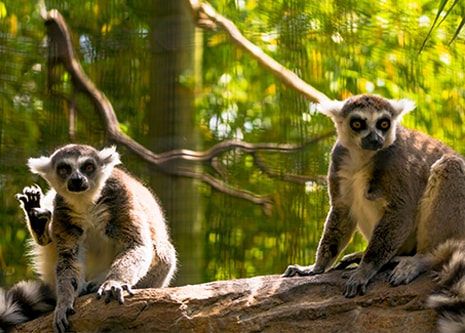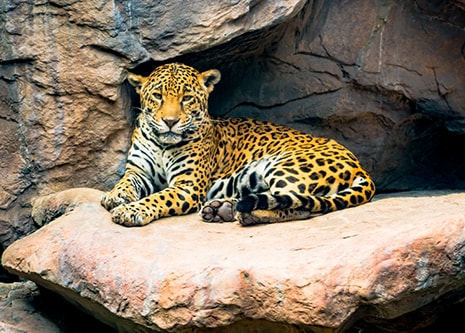
- VisitSupport Happy HollowDONATE TODAYExploreSupport Happy HollowDONATE TODAYLearnSupport Happy HollowDONATE TODAYSupport
-
Today's Hours: 10:00 am to 5:00 pm
Education AmbassadorsPrehensile-tailed skink


Scientific name: Corucia zebrata
Family: Scincidae
Order: Squamata
Class: Reptilia
Range: Solomon Islands
Habitat: Tropical Rainforest
Lifespan: 15 to 20 yearsWhat do they look like?
Prehensile-tailed skinks are a relatively large species of lizard, growing up to 30 inches long. They have powerful legs and a prehensile (capable of grabbing or grasping) tail. They have long toes equipped with sharp claws. These adaptations all contribute to the completely arboreal (tree dwelling) lifestyle of these reptiles. Their heads are broad and wedge-shaped. They have powerful jaws lined with small teeth. Their color ranges between different shades of green, with their heads being slightly more yellow. The species name, zebrata, refers to the reptile’s marbled striped coloration, like that of a zebra.How do they behave?
Unlike most reptiles, prehensile-tailed skinks often live in a social group called a circulus. Males and females alike are both territorial and will protect their family group. They are primarily nocturnal (active at night) using their exceptional camouflage to remain undetected while at rest during the day. They rely heavily on their sense of smell to forage for food at night. Prehensile-tailed skinks obtain the majority of their water needs through their diet and rarely climb down to the ground to drink.What do they eat?
Despite their large jaws, these skinks are herbivores. They feed on the leaves, flowers and fruit of the trees they live in. Juvenile skinks also eat feces from the adults in their circulus to acquire essential bacteria that aids them in digesting their fibrous diet. At Happy Hollow, they eat fruit, vegetables and greens.How are they born?
Unlike nearly all reptiles, these skinks do not lay eggs. Instead they are ovoviviparous (they birth to live young encased in membranous sacs). Females have a relatively long gestation period of six to eight months. A single neonate (newborn) is born roughly one third the size of its mother. Twins are rare. Juveniles will stay with the circulus (group of reptiles) for at least several months, often up to one year, before venturing out to start a new family group. During this time, adults in the circulus, even those not closely related, protect the young.Conservation
The prehensile-tailed skink’s conservation status has not been evaluated by the International union for Conservation of Nature . Two of the biggest threats to these animals are habitat loss and exportation for the exotic pet trade. Often rainforest land in the Solomon Islands is harvested for logging or agriculture. One organization working towards protection of rainforest land is the Rainforest Alliance. This group focuses on balancing the needs of local communities with rainforest habitat preservation. If you would like to help protect rainforest habitat you can start by simply recycling your paper products. If you would like to take your conservation action a step further, you can commit to purchasing coffee that is shade-grown and produce that is grown locally. These items do not require the destruction of rainforest land to grow. If you are curious whether your coffee, chocolate, or fruit is rainforest friendly, look for the rainforest alliance seal of certification. To learn more visit http://www.rainforest-alliance.org
Zoo on the Hill
Located across from the Keep-Around Carousel is the Zoo on the Hill. Learn about wildlife up close during daily meet-and-greets, leap like a lemur on the playground, brush and feed the goats,, or take a peek inside Doc’s Critter Care building and the Ranch House. Double-H Ranch features a combination of animal exhibits, including giant anteaters and red ruffed lemurs, as well chickens and domesticated animals that are docile enough to touch.
See Animals
Zoo in the Hollow
Follow the crooked bamboo pathway down into the hollow and visit with some of the most amazing animals in the world. Where else in San José can you get up close to a stunning jaguar, lemur, meerkat or American alligator? Happy Hollow is dedicated to helping save species and preserve wildlife for future generations by participating in Species Survival Plan programs through the Association of Zoos and Aquariums.
See AnimalsVisit Us Today
Plan an unforgettable experience at San Jose’s family-friendly park and zoo.
more info